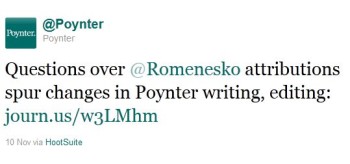
(Credit: Twitter, screenshot)
When I was in law school, a professor told an apocryphal story about a judge who bragged that he was the worst judge around. When asked why, he replied, “I always follow the law.” In popular culture, strict adherence to laws, rules, principles and anything else that adults tell children are the guideposts for correct behavior is the preserve of the deeply uncool. In movies from Ghostbusters to The Terminal and beyond, the bad guy is the bureaucrat who scrupulously applies the law.
Anyone wishing to keep his coolness, which has become a prerequisite for enjoying electronic media to the fullest, should consider that before taking sides in the controversy concerning the Nov. 10 resignation of Jim Romenesko from his blog on the Poynter Institute’s website. I am both a lawyer and a traditional journalist, which makes me deeply and proudly uncool. So it is with a mixture of bewilderment and amusement, topped with a dollop of empathy, that I have come out on the side of the cool people in concluding that way too much was made out of far too little, to the injury of no one but the writer and his employer/accuser.
Backstory
The story is that Jim Romenesko, who was influential in pioneering Internet-based news aggregation, had aggregated news content in his blog on the website, which is run by the Poynter Institute. For twelve years running, Romenesko would typically read reports written by others, summarize the contents and post the summaries on his blog, along with, for each, a link to the source material. At all times, the source would be clearly identified.
In the course of his many years, Romenesko generally followed his employer’s requirements to attribute all the source text he used by placing it between quotation marks. It turns out that many of his summaries did not contain quotation marks, with the result that it could be unclear whether portions of text were authored by Romenesko or the source author of the piece being summarized.
Founded in St. Petersburg, Florida in 1975, the Poynter Institute is dedicated to providing education and related services to improve the standards and practices of journalism. So when Columbia Journalism Review’s associate editor Erika Fry brought to the attention of Romenesko’s boss, Julie Moos, that he was not consistently following the Institute’s practices for attribution in identifying the source of text in his summaries, she posted an announcement that was part mea culpa, part gentle public scolding: henceforth, Romenesko, who alone had been permitted to publish on the website without editing, would be denied that privilege. Romenesko, who was seven weeks short of an already announced semiretirement, offered to resign over the matter, first to the protest of Moos and then with her acceptance. At Internet speed, journalists and commentators from all over took sides. The comments centered on two basic issues: plagiarism and attribution.

Jim Romenesko resigned from Poynter Nov. 10 (Credit: Twitter)
I admire my fellow journalists for their consistent grace under pressure, but I am also aware that news gathering and reporting is a messy business. Although few will own up to it, the truth is that accuracy is all too easily compromised for speed. On occasions in which I have been the subject of news pieces or quoted in them, I have been struck by the sincerity of the reporters, even as I have been surprised by how inaccurate their reporting can be. Part of the problem is that so much happens so quickly in the news, it is hard to gain subject matter expertise before you publish. That is surely why, in this situation as in so many others, much that has been written is not quite correct, starting with the nature of the problem, which has routinely been called one of plagiarism.
Plagiarism and the Law
Under the common law, to commit plagiarism, an author must copy or closely paraphrase text written by another and pass it off as his own. It is an act of deception—a deliberate attempt to “steal” from an author’s text and to claim, at least in the literary sense, direct ownership of it. The Copyright Act of the United States preempts any common law right that is covered by the provisions of the Act. As a practical matter, therefore, very little of the common law of plagiarism remains. It is theoretically possible that you could plagiarize text in the public domain (public domain material is not protected under the Copyright Act), but who is going to complain about that?
So although even institutions of learning, including law schools, maintain policies against what they call plagiarism, were anything of what Romenesko has done to come to the courts, it would instead be as a claim of copyright infringement filed by copyright holders of the summarized articles.
Under Section 107 of the Copyright Act, fair use is a defense to any such claim. It is the doctrine of fair use that allows aggregators to take limited portions of copyright-protected text and quote and closely paraphrase from them in their summaries. For the purposes of fair use, it does not matter all that much if you put quotation marks around the text. Use so much of it that you effectively take the market for the original material—if you copy or slightly adjust enough of what the original reporter wrote that the reader would probably feel it was unnecessary to go to the source—and the defense of fair use could well be denied you.
So quotation marks or none, Romenesko’s behavior under law would be subject to the same standard of review, and the consequences of infringement would probably be about the same. (There are other possible claims as well, but copyright infringement would be central to the case.)
Thank You for Small Favors
The very electronic facilities, especially the Internet, that have given rise to the craft of news aggregation have also given rise to something else: considerable unemployment and loss of revenue by journalists and news organizations. Time was that a journalist would write something, get paid for it, and use the proceeds to pay for the necessities and caprices of life while writing the next piece. As any twelve-year-old will inform you, if your electronic device can pick up content, you are morally entitled to read it, regardless of who out there might think he or she should get paid for it—and regardless of the simple truth that it is quite often illegal to do so. These days, you are probably lucky, when you get pirated, if the pirate at least gives you credit for having been the victim of his misdeed. Argue all you want against that user-take-all mentality, as those of us who advocate on behalf of authors and artists do, but the Zeitgeist is not playing on our team.
That fact has helped contribute to a new thinking regarding publication, a point of view that has become popular in academic circles and elsewhere: since you cannot effectively control the use of text anymore, traditional copyright principles can no longer effectively be applied. What you must always give, however, is due attribution to the source. That is in part the thinking behind movements such as Creative Commons and the Fair Use Project at Stanford Law School.
A cynic would say that the idea appears to be that authors do not necessarily write for money but for flattery, of which imitation, after all, is its sincerest form. To those of us in the copyright bar with a more traditional view (mindful of Samuel Johnson’s admonition that, “No man but a blockhead ever wrote, except for money.”), the writer who identifies, as an act of gratitude, the author whose work he or she “appropriated” does not thereby justify copying without consent.
Looking at Romenesko’s conduct in light of all that, it is hard to see, from a legal point of view, what, if anything, went wrong. For either infringement or old-fashioned plagiarism, it is a very poor miscreant who would steal the words of another in conjunction with a link straight to the very source of those words. As for attribution, no one is claiming that Romenesko did not name his sources. The only issue is whether he named the source of this sentence or that within the compressed column inches of his summaries.
Poynter and its Policies
So the question then becomes whether the quotation marks, those essential, missing keyboard characters of the Columbia Journalism Review watchdogs and the Moos declaration, were really the dividing line between right and wrong. The answer is that it is far too simplistic, both as a matter of law and of good punctuation, to say that question marks are necessary—even if using them might be the method chosen by the Poynter Institute in the enforcement of its policy. Indeed, the institute’s published policy does not mention quotation marks; their use is mandated internally only by custom and practice under the policy.

Poynter’s published policies don’t specifically address the use of quote marks. (Credit: Poynter, screenshot, highlight added)
A better test to be used here is whether a typical reader of a Romenesko summary would not, in context, understand that the words that were quoted but not placed within quotation marks were those of the author or of the reporter being summarized.. That is, could quotation of text can be inferred from the use of other devices (such as indentation of quoted text) and from context?
Standards for Aggregation
Romenesko pioneered aggregation, and like many new forms, aggregation developed its own conventions. When The New York Times summarizes its articles on the home page of its website, it does what Romensko did: it copies words from the text being summarized. The Times is not going to sue itself, of course, but readers are very familiar with the fact that, when an article is summarized in electronic media, original text may have been copied or closely paraphrased.
The craft of abridgment has been with us for a very long time, of course. Lawyers are trained to shy away from paraphrase in court briefs, treatises and articles because critical meaning can be lost. By long tradition, the headnotes (summaries of points of law) put into a case report of a judicial decision will contain as much copied text from the reported decision as is necessary convey meaning. Quotation marks are never used, but convention tells us that the true author of much or even most of the headnote text is the judge whose decision is being summarized.
As with so many intellectual scuffles of this kind, the result of l’affaire Romenesko is paradox: any reader whom Romenesko would make interested enough in the underlying story to read it would click on the link and thereby see exactly which words came from that piece; anyone not so interested would turn away without caring who authored any of the content involved.
If too much of the source text was used, there would be copyright infringement regardless of attribution, and no sensible lawyer is going to file a complaint about a something as small as an aggregator’s summary if copyright infringement cannot be named as the first basis for relief. Whatever the moral or ethical stand, therefore, it is hard to see where real harm has been done by the loss of quotation marks.
What appears actually to be at issue here is the ongoing struggle between the rules of traditional journalism and the “rules” of the Internet and other interactive facilities. Trying to apply traditional rules to the new wave in electronic media is like trying to impose the rules Olympic boxing onto a barroom brawl. The Internet and other facilities have made copyright infringement a participatory sport, which is why many of the talented editors who taught me the craft of journalism were nudged out of their jobs and why, although my own journalism used to be a decent supplement to income, it is now largely a labor of love.
Conceptually, there was nothing wrong with the assessment made by Julie Moos of the problem prompted by Columbia Journalism Review’s investigation of Romenesko (and other Poynter writers), but her method of handling it—posting a public declaration that is both censorious and apologetic—is painfully characteristic of academic self-righteousness. It instantly turned an internal quality-control matter into needless public catharsis. Would that Moos had done what any good businesswoman would have done in such a situation and first contacted her publicist. (If she actually did that—Julie, please, get yourself a new PR company.)
As in many great tragedies, everything went wrong because everybody was right. The Poynter Institute was right that it should set and work to maintain high standards of journalism, and that its bloggers, like everyone else, should properly quote their sources. And Romenesko’s followers would be right to observe that aggregation works by its own rules, now largely respected by all; that mistakes are made when people get careless and things go as fast as the Internet requires; that, in context, it was pretty easy all along to see what words were Romenesko’s and what words belonged to the sources; and that, perhaps most important of all, since so many of the reporters whose work was aggregated were grateful for the attention Romenesko brought to their work, why would anyone possibly care anyway?
If Shakespeare were around today and if he were interested in the lives of reporters (not likely, but we can dream), he probably could make a very good play out of this. As for the rest of us, we can only look to the Poynter Institute and say: very well, you are absolutely right—now what?
 |
Alan Behr, a partner in the New York office of Alston & Bird and the head of the firm’s Electronic Entertainment and Fashion & Luxury Goods practices, counsels many of the world’s leaders in the fields of electronic entertainment, print publishing, fashion and consumer products. He is regularly invited to write for legal and general-interest journals and to speak at international legal and business conferences. Mr. Behr is recognized as one of the leading intellectual property lawyers in Best Lawyers in America and Super Lawyers. |

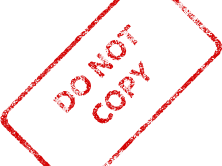
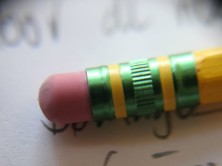

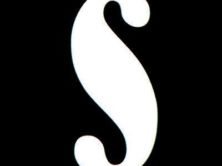

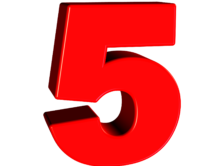
Comments Terms and Conditions